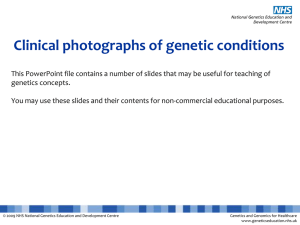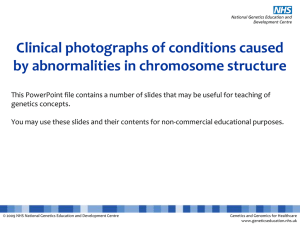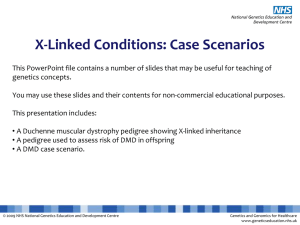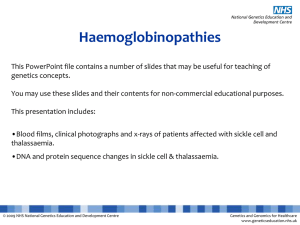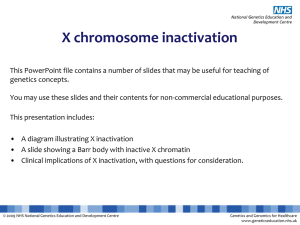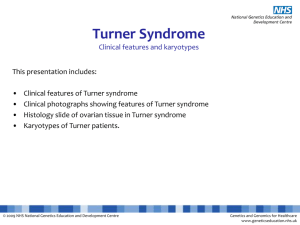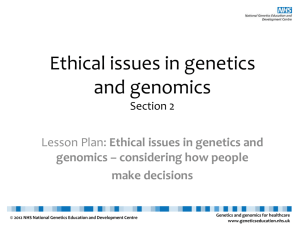Cystic fibrosis - National Genetics Education Centre
advertisement
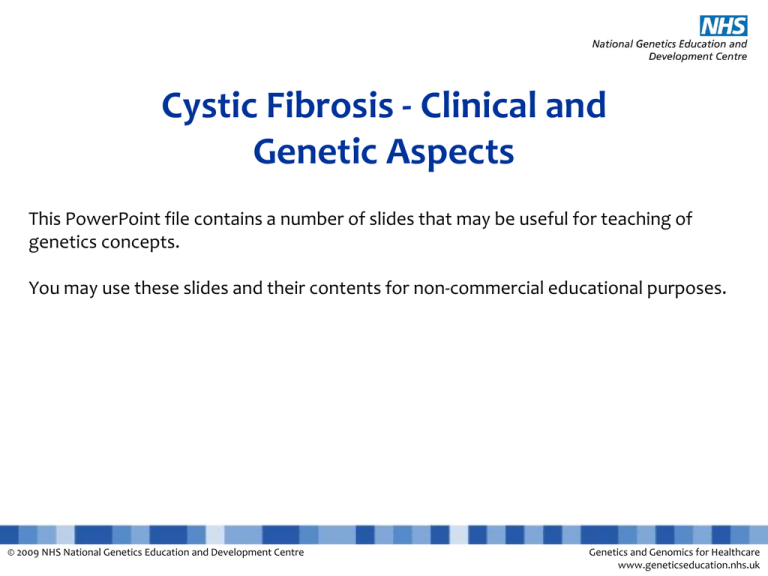
Cystic Fibrosis - Clinical and Genetic Aspects This PowerPoint file contains a number of slides that may be useful for teaching of genetics concepts. You may use these slides and their contents for non-commercial educational purposes. © 2009 NHS National Genetics Education and Development Centre Genetics and Genomics for Healthcare www.geneticseducation.nhs.uk Cystic Fibrosis This presentation contains: • Clinical manifestations of CF. • Clinical photographs and X-rays. • Molecular genetic basis of CF, including the structure of the CFTR gene, PCR and sequencing. • Examples of pedigrees and explanation of risk calculation. • CF Case scenario. © 2009 NHS National Genetics Education and Development Centre Genetics and Genomics for Healthcare www.geneticseducation.nhs.uk Cystic fibrosis • Affects 1 in 2,500 babies in the UK (240 babies annually) • Recessively inherited • Lifelong, life-limiting illness • Affects the lungs, digestive tract and pancreas by clogging them with thick, sticky mucus • Daily physiotherapy, dietary supplements and intensive treatment for chest infections © 2009 NHS National Genetics Education and Development Centre Genetics and Genomics for Healthcare www.geneticseducation.nhs.uk Cystic Fibrosis (1) Commonest AR-inherited disease amongst Northern European Caucasians • Incidence in UK Caucasian population 1 in 2,500 carrier risk 1 in 25 • Incidence in UK Asian population 1 in 10,000 carrier risk 1 in 50 © 2009 NHS National Genetics Education and Development Centre Genetics and Genomics for Healthcare www.geneticseducation.nhs.uk Cystic Fibrosis (2) •Gland secretions thicker or more viscous than normal •Small bowel: obstruction (meconium ileus in the newborn) •Lungs : thick bronchial mucous, recurrent chest infections, progressive lung damage, heart/lung transplantation © 2009 NHS National Genetics Education and Development Centre Genetics and Genomics for Healthcare www.geneticseducation.nhs.uk Cystic Fibrosis (3) •Pancreas: failure to secrete digestive enzymes causing malabsorption, failure of growth and late development •Men nearly always infertile – absence/atrophy of vas deferens •Lifelong potentially fatal disease © 2009 NHS National Genetics Education and Development Centre Genetics and Genomics for Healthcare www.geneticseducation.nhs.uk Cystic Fibrosis Gene •Large gene encoding 1480 amino acids •Over 1,100 different mutations identified in the gene •Routinely test for 29 commonest mutations •If mutation/s not found in clinically affected child - send DNA to laboratory to be tested for rarer mutations © 2009 NHS National Genetics Education and Development Centre Genetics and Genomics for Healthcare www.geneticseducation.nhs.uk Cystic fibrosis gene mutations •Commonest mutation – Delta F508 UK Caucasians - 75% UK Asians - 29% •Common mutation found in 1 in 10 UK Asians - Y569D (substitution G - T) •Delta F508 and 28 others account for 85% mutations in the Northern European Caucasian population © 2009 NHS National Genetics Education and Development Centre Genetics and Genomics for Healthcare www.geneticseducation.nhs.uk Cystic fibrosis (a) The outlook for cystic fibrosis patients has improved over the years but they still need frequent hospital admissions, physiotherapy and constant medications. (b) Chest X-ray of lungs of cystic fibrosis patient. (c) Erect abdominal film of newborn with meconium ileus showing multiple fluid levels. Photos (a) and (b) courtesy of Dr Tim David, Royal Manchester Children’s Hospital. Fig. 1.2 ©Scion Publishing Ltd Photos (a) and (b) courtesy of Dr Tim David © 2009 NHS National Genetics Education and Development Centre Genetics and Genomics for Healthcare www.geneticseducation.nhs.uk Pedigree of Joanne Brown’s family Note the complete absence of any family history of cystic fibrosis. Autosomal recessive conditions commonly present as a single isolated case. Fig. 1.8 ©Scion Publishing Ltd © 2009 NHS National Genetics Education and Development Centre Genetics and Genomics for Healthcare www.geneticseducation.nhs.uk Structure of the CFTR gene An alternative graphical display of Human Genome Project data, as displayed by the ENSEMBL genome browser. Some closely spaced exons appear as a single bar. The arrow shows the 5’ → 3’ direction of the sense strand. Fig. 3.8 ©Scion Publishing Ltd © 2009 NHS National Genetics Education and Development Centre Genetics and Genomics for Healthcare www.geneticseducation.nhs.uk A multiplex allele-specific PCR test for 29 common CFTR mutations The same seven samples are amplified with different cocktails of primers in the two gels. No mutation is detected in lanes 3 or 4. Extra bands in the other lanes define particular mutations by their presence and size. Fig. 5.10 ©Scion Publishing Ltd Photos courtesy of Victoria Stinton and Roger Mountford © 2009 NHS National Genetics Education and Development Centre Genetics and Genomics for Healthcare www.geneticseducation.nhs.uk DNA sequencer trace of part of the exon 14b PCR product from Joanne Brown’s CFTR gene At the arrowed position G and C nucleotides are both present, showing that Joanne is heterozygous for a nucleotide substitution (remember that the products of PCR and sequencing are normally a mix of the products from the two alleles). Control samples show only the G. It is usual to sequence both strands of the DNA separately to confirm any change. In this case the sequence shown is of the reverse strand, so in the sense strand the change in Joanne is C>G. Fig. 5.12 ©Scion Publishing Ltd © 2009 NHS National Genetics Education and Development Centre Genetics and Genomics for Healthcare www.geneticseducation.nhs.uk George d 42 yrs RTA Robert 22.8.70 Ruth 18.1.72 Helen 1.5.74 June 5.10.50 James 9.6.76 adopted Sally 6.4.79 Paul 15.2.81 Aaron 3.7.84 P Harry 3.9.93 Jane 12.6.96 Sally (1999): 7 weeks pregnant, niece recently diagnosed with Cystic Fibrosis Emergency referral by GP (by telephone) © 2009 NHS National Genetics Education and Development Centre Genetics and Genomics for Healthcare www.geneticseducation.nhs.uk
